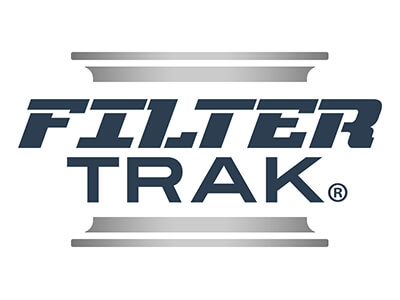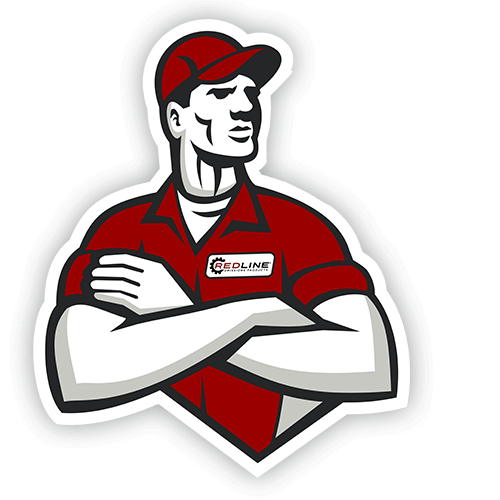Investigate the Root Cause of DPF Failure Before Submitting a DPF Warranty Claim
Most folks in the truck industry strongly dislike diesel emissions systems, especially Pete. We got to know Pete when his shop submitted a DPF warranty claim to us; by that time, he was highly frustrated. He had to bring his truck to a DPF cleaning facility twice within a month because his DPF kept getting clogged.
Pete felt that the whole diesel emissions system was just a money-pit; he had a 1996 DD15 engine that ran without a problem for twenty years, but his new truck has had an issue with the aftertreatment system every six months since he bought it four years ago. Let alone the price of diesel and DEF, this new truck was about to bring him face to face with bankruptcy.
What went wrong for Pete?
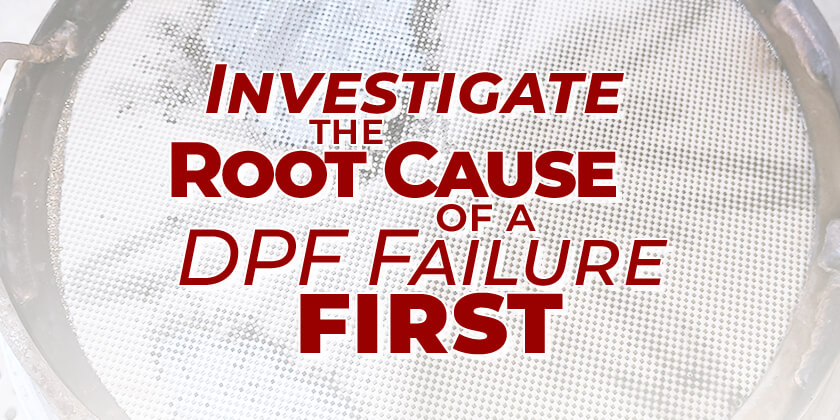
The Canary in the Diesel Truck
The diesel emissions system is sensitive, and it must be in proper working order to do its job. So, when there is a problem upstream in the engine or downstream in the aftertreatment system, the DPF or DOC will show it, much like a canary in a coal mine. And, even if an engine issue is fixed, it could have caused unexpected effects on the emissions system.
What DPF Cleaning Facilities and Repair Shops Often Get Wrong.
DPF cleaning facilities make money by cleaning DPFs and DOCs, so they don’t have much incentive to investigate problems when a DPF like Pete’s shows up. In fact, Pete’s frustration with having to get his DPF cleaned twice in one month meant more business for his DPF cleaning shop – in the short term.
Meanwhile, repair shops make money by fixing issues and replacing parts. They don’t usually like to spend too much time investigating the root cause of an issue that is having consequences up or downstream. Pete’s repair shop simply replaced his DPF, and when there was a problem with it, they tried to submit a warranty claim to us.
Do you understand Pete’s frustration? He had no one really looking out for his best interests – not his DPF cleaning facility or his repair shop. It was up to us to figure out the real problem for Pete.
Finding the Root Cause
We got in contact with Pete’s repair shop and asked a few important questions, starting with if the shop had completed a DOC efficiency test. They answered no and informed us that they had recently replaced Pete’s EGR cooler and sent him on his way. Unfortunately within a few weeks, Pete ended up at a DPF cleaning facility with a clogged filter. Within a month he was back at the cleaning facility again. Pete’s shop decided that his DPF must not be any good and installed a Redline Emissions Products® aftermarket DPF. After another month, Pete’s truck was still showing high back pressure, so Pete headed back to his shop again, frustrated. The shop felt the problem must have been from bad DPF and sent it in for a warranty claim.
Pete’s shop should have done a DOC efficiency test after the EGR cooler was found to be defective. The shop should have also done this same test after the filter plugged up several times and had to be cleaned.
The shop finally did a DOC efficiency test at our request and found that the DOC was poisoned. Many technicians still don’t know that ethylene glycol from coolant and excessive lube oil can degrade the regeneration capacity of a catalyst quickly.
Pete’s saga ended with a new DOC that he should have gotten months ago – and that he only got because his shop tried to take the easy way out by submitting a DPF warranty without doing some investigating first.
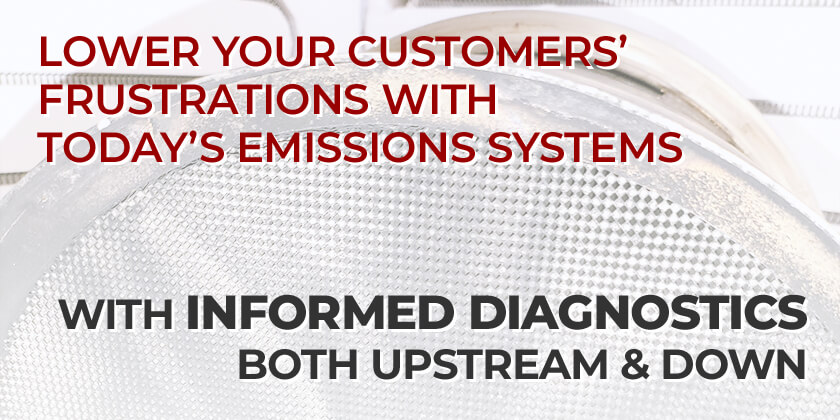
Don’t Be Like Pete’s Repair Shop or DPF Cleaning Facility
We know that truck drivers often dislike diesel emissions systems, and if you’re a shop or facility that works with this system, your customers are angry before they even step foot in your shop. Providing your customers with a top-quality experience is essential to avoid getting bad-mouthed on Yelp or at the truck stop. Unfortunately for Pete, his shop didn’t know this.
Pete’s repair shop failed to run diagnostics to see why his DPF was getting clogged so often. In fact, they should have done a DOC efficiency test right after his EGR was replaced, to ensure the rest of the aftertreatment components were still in good working order. If Pete’s shop had done this, he could have saved a lot of money, time, and frustration. Instead, Pete’s shop took the easy way out by blaming the DPF itself – and now they’ve lost a customer.
The DPF cleaning facility that Pete used failed to communicate with him and with his repair shop. A good DPF cleaning facility doesn’t just clean DPFs and get paid; it values its customers and lets them know about the state of their filters and if there are any possible upstream issues that need to be corrected. Although doing so does take more time and effort, your DPF cleaning facility will earn loyal, repeat customers and benefit from word-of-mouth marketing. On the other hand, you’d better believe that Pete is telling his fellow drivers to avoid the DPF cleaning facility that let him down.
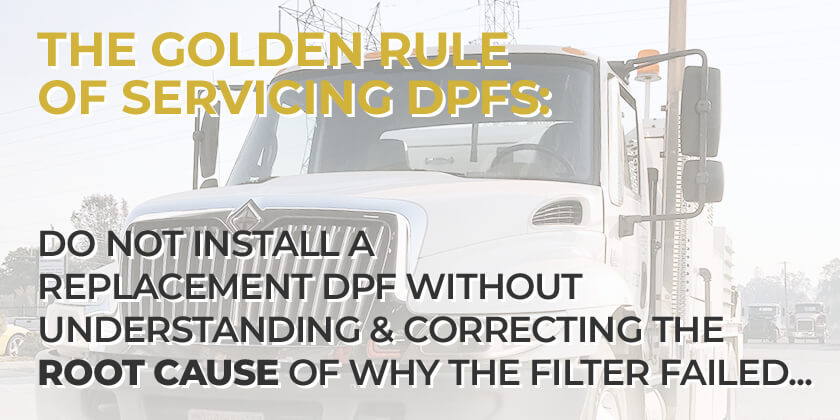
Get Ahead of Your Competition with One Simple Rule
We follow the golden rule of servicing DPFs: Do not install a replacement DPF without understanding and correcting the root cause of why the filter failed in the first place.
Whenever there is a DPF issue, shops need to use diagnostic tools to help them see what the real issue is. Pete’s shop failed to do this for him and who knows how many other customers. You now know better than to simply submit a DPF warranty claim without doing this crucial step.
Bonus Tip
Pete’s shop could have saved a lot of trouble by using a filter tracking system like Filtertrak. This online software tool allows shops and fleets to easily record, store, and analyze DPF cleaning data like before/after weight and flow readings, as well as pictures to a service record/history that is all quickly accessible.
Having a filter tracking system like Filtertrak could have alerted Pete’s cleaning facility that something was not right, as it is not normal to clean a DPF more than once a year or every 75,000 miles under normal conditions.
At Redline Emissions Products®, we not only know aftertreatment parts but are also experts in DPF maintenance and cleaning. We have over 40 years of experience servicing diesel vehicles, and we know how to supply reliable OEM replacement filters for all makes.
Become a REP Dealer
If you sell heavy-duty parts and want to get into the business of selling aftertreatment replacement parts and/or providing DPF cleaning to your customers, contact us today to discuss becoming one of our parts distributors.
Contact Anthony Soto, National Sales Manager for REP to find out more. Call 888-295-4670
Need Tech Support or need help troubleshooting a DPF problem? No problem! Contact REP Support at 1-888-564-4209



